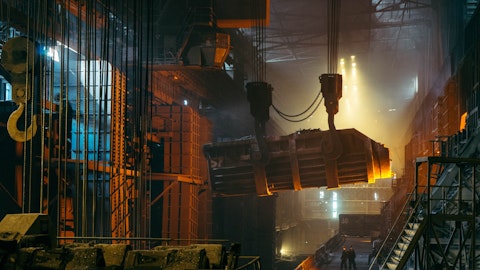Mike Williams: A significant amount of it is related to the demand growth in defense-related products that we manufacture. However, we’ve seen also a richer alloy mix as well in the industrial sector.
Philip Gibbs: And then there was a big pickup in pricing and mix is sort of across all your target markets, auto, industrial and energy, obviously really, really notable. Is there any of that that over the next couple of quarters will normalize a bit, because there was a bit of a step change in the quarter that was unique?
Mike Williams: Yes. There was some retroactive pricing that was caught up in Q3, but that’s — those are solid annual agreements, and that pricing will continue going forward. That was one of the big influencer besides the richer mix tied to the defense market sector and the alloy mix product.
Philip Gibbs: Okay. So some catch-up on pricing or orders that maybe were backlogged from some of the operational issues last year?
Mike Williams: Yes. I would say it’s more retroactive pricing that went back a couple of quarters. They got caught up in Q3.
Philip Gibbs: Great. And then lastly, anything on the conversion cost side that’s notable between energy alloys, consumables, anything like that that could be changing? Or how does it compare to last year?
Mike Williams: You mean for 2024?
Philip Gibbs: I just mean in terms of trends, in terms of what you’ve seen at present and how that maybe compares to last year? Thank you.
Mike Williams: Yes. I think the most of our consumables and energy requirements, whether it be gas, electricity or annual contracts or longer-term contracts. So I think those pricing from that perspective is flat to the remainder of this year. And we’re in the progress of negotiating — beginning the negotiation of our supply contracts for 2024. So too early to tell you how that’s going to play out, but we’ll know probably by the end of the year.
Philip Gibbs: Thank you.
Mike Williams: Thanks, Phil.
Operator: [Operator Instructions]. Our next question comes from Dave Storms from Stonegate Capital Markets. Please go ahead. Your line is open.
Unidentified Analyst: Good morning. This is John stepping in for Dave.
Mike Williams: Hey, John.
Unidentified Analyst: Hi, so you had mentioned utilization was 76% in the quarter and it’s supposed to decrease in Q4. So relative to historical levels, what are your expectations for 2024, was reaching 80% a reasonable expectation?
Mike Williams: Yes. I mean that’s our target average per quarter. We would have been there in Q3. However, we had an environmental system that malfunction and we had to be down for a couple of days of repair at our melt shop. So we would have been definitely at slightly above 80%, if that wasn’t the case for Q3. And that is our — basically our target for 2024. And we’ve given you the reasons why Q4 will be lower.
Unidentified Analyst: Got it. Very helpful. Thank you. And then cost improvements that remain in Q3, which ones are structural, which of them are discretionary [indiscernible]?
Mike Williams: Well, I mean, most of our cost improvements are going to be structural outside of supply agreements and arrangements in raw material purchases and energy purchases, those can vary. But when we look at our manpower, we look at our productivity, we look at our yield and cost of quality, those things are all structural improvements. And that’s what we’ve been focused on. A number of investments that were implemented during the outage, we’ll start to see those improvements through the remainder of this year and for the full-year 2024.
Unidentified Analyst: Okay. Got it. Thank you. Appreciate you taking my questions.
Mike Williams: Thank you.
Operator: Our next question comes from John Franzreb from Sidoti. Please go ahead. Your line is open.
John Franzreb: Yes, just a couple of quick follow-ups. Firstly, how does the capital expenditure outlook change in 2024 versus 2023? I know you got the additional piece of equipment that you’re putting in at the end of next year, but can you kind of ballpark what the CapEx spend looks like for next year?



